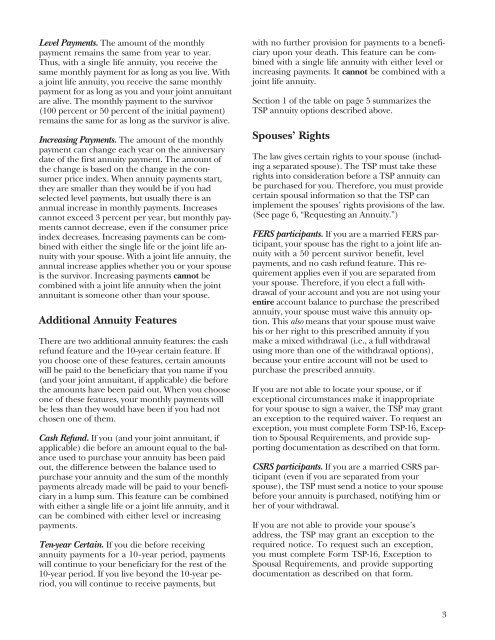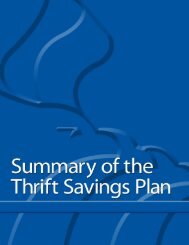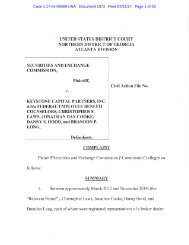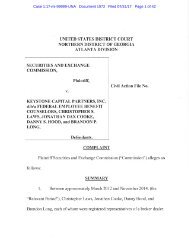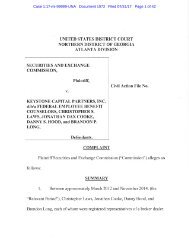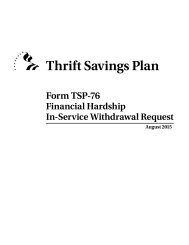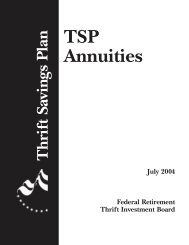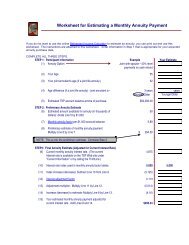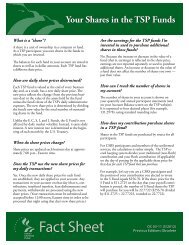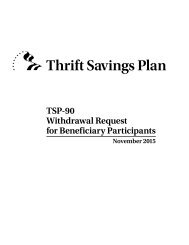Additional TSP Information
Create successful ePaper yourself
Turn your PDF publications into a flip-book with our unique Google optimized e-Paper software.
Level Payments. The amount of the monthly<br />
payment remains the same from year to year.<br />
Thus, with a single life annuity, you receive the<br />
same monthly payment for as long as you live. With<br />
a joint life annuity, you receive the same monthly<br />
payment for as long as you and your joint annuitant<br />
are alive. The monthly payment to the survivor<br />
(100 percent or 50 percent of the initial payment)<br />
remains the same for as long as the survivor is alive.<br />
Increasing Payments. The amount of the monthly<br />
payment can change each year on the anniversary<br />
date of the first annuity payment. The amount of<br />
the change is based on the change in the consumer<br />
price index. When annuity payments start,<br />
they are smaller than they would be if you had<br />
selected level payments, but usually there is an<br />
annual increase in monthly payments. Increases<br />
cannot exceed 3 percent per year, but monthly payments<br />
cannot decrease, even if the consumer price<br />
index decreases. Increasing payments can be combined<br />
with either the single life or the joint life annuity<br />
with your spouse. With a joint life annuity, the<br />
annual increase applies whether you or your spouse<br />
is the survivor. Increasing payments cannot be<br />
combined with a joint life annuity when the joint<br />
annuitant is someone other than your spouse.<br />
<strong>Additional</strong> Annuity Features<br />
There are two additional annuity features: the cash<br />
refund feature and the 10 - year certain feature. If<br />
you choose one of these features, certain amounts<br />
will be paid to the beneficiary that you name if you<br />
(and your joint annuitant, if applicable) die before<br />
the amounts have been paid out. When you choose<br />
one of these features, your monthly payments will<br />
be less than they would have been if you had not<br />
chosen one of them.<br />
Cash Refund. If you (and your joint annuitant, if<br />
applicable) die before an amount equal to the balance<br />
used to purchase your annuity has been paid<br />
out, the difference between the balance used to<br />
purchase your annuity and the sum of the monthly<br />
payments already made will be paid to your beneficiary<br />
in a lump sum. This feature can be combined<br />
with either a single life or a joint life annuity, and it<br />
can be combined with either level or increasing<br />
payments.<br />
Ten-year Certain. If you die before receiving<br />
annuity payments for a 10 - year period, payments<br />
will continue to your beneficiary for the rest of the<br />
10 - year period. If you live beyond the 10 - year period,<br />
you will continue to receive payments, but<br />
with no further provision for payments to a beneficiary<br />
upon your death. This feature can be combined<br />
with a single life annuity with either level or<br />
increasing payments. It cannot be combined with a<br />
joint life annuity.<br />
Section 1 of the table on page 5 summarizes the<br />
<strong>TSP</strong> annuity options described above.<br />
Spouses’ Rights<br />
The law gives certain rights to your spouse (including<br />
a separated spouse). The <strong>TSP</strong> must take these<br />
rights into consideration before a <strong>TSP</strong> annuity can<br />
be purchased for you. Therefore, you must provide<br />
certain spousal information so that the <strong>TSP</strong> can<br />
implement the spouses’ rights provisions of the law.<br />
(See page 6, “Requesting an Annuity.”)<br />
FERS participants. If you are a married FERS participant,<br />
your spouse has the right to a joint life annuity<br />
with a 50 percent survivor benefit, level<br />
payments, and no cash refund feature. This requirement<br />
applies even if you are separated from<br />
your spouse. Therefore, if you elect a full withdrawal<br />
of your account and you are not using your<br />
entire account balance to purchase the prescribed<br />
annuity, your spouse must waive this annuity option.<br />
This also means that your spouse must waive<br />
his or her right to this prescribed annuity if you<br />
make a mixed withdrawal (i.e., a full withdrawal<br />
using more than one of the withdrawal options),<br />
because your entire account will not be used to<br />
purchase the prescribed annuity.<br />
If you are not able to locate your spouse, or if<br />
exceptional circumstances make it inappropriate<br />
for your spouse to sign a waiver, the <strong>TSP</strong> may grant<br />
an exception to the required waiver. To request an<br />
exception, you must complete Form <strong>TSP</strong>-16, Excep -<br />
tion to Spousal Requirements, and provide sup -<br />
porting documentation as described on that form.<br />
CSRS participants. If you are a married CSRS participant<br />
(even if you are separated from your<br />
spouse), the <strong>TSP</strong> must send a notice to your spouse<br />
before your annuity is purchased, notifying him or<br />
her of your withdrawal.<br />
If you are not able to provide your spouse’s<br />
address, the <strong>TSP</strong> may grant an exception to the<br />
required notice. To request such an exception,<br />
you must complete Form <strong>TSP</strong>-16, Exception to<br />
Spousal Requirements, and provide supporting<br />
documentation as described on that form.<br />
3


